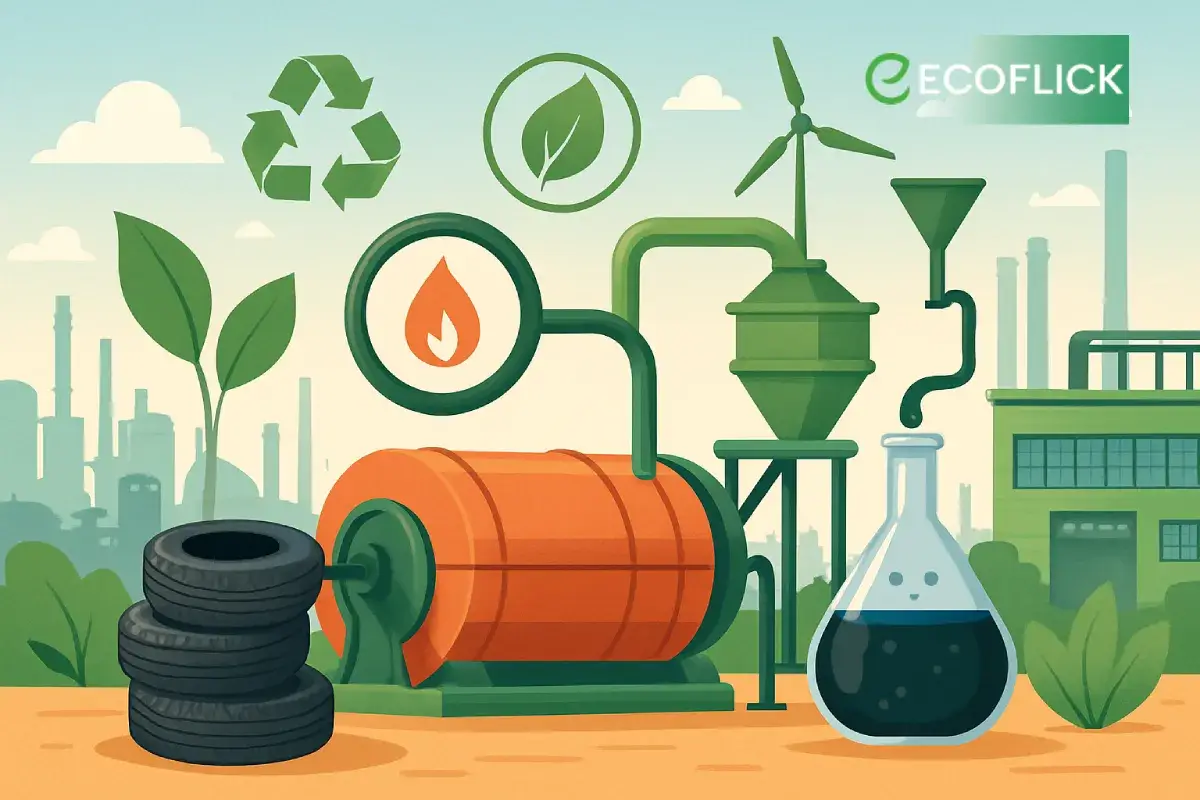Introduction
India discards over 275 million waste tyres
annually, with only 6-7% being recycled—the rest end up in
landfills, illegal dumps, or are burned, causing severe environmental and
health hazards. However, tyre pyrolysis, an advanced thermal
decomposition process, is revolutionizing waste management by converting
discarded tyres into Tyre Pyrolysis Oil (TPO), a valuable
industrial fuel.
This blog dives deep into the science,
economics, and future potential of TPO in India, backed by verified data,
government policies, and real-world applications.
What is Tyre Pyrolysis Oil
(TPO)?
TPO is a dark, high-calorific fuel extracted
by heating waste tyres at 300–500°C in an oxygen-free environment (pyrolysis).
The process breaks down tyres into:
|
Product |
Yield (%) |
Applications |
|
Pyrolysis Oil (TPO) |
40-45% |
Industrial fuel, power generation |
|
Carbon Black |
30-35% |
Rubber manufacturing, paints, inks |
|
Steel Wires |
10-15% |
Scrap metal industry |
|
Pyrolysis Gas |
10-15% |
Reused as process fuel |
Key Properties of TPO
✔ Calorific Value: 38-42 MJ/kg (Comparable to diesel at ~45 MJ/kg)
✔ Sulfur Content: 0.5-1.5% (Lower than heavy furnace oil at ~3-4%)
✔ Density: 0.91-0.96 g/cm³
Why TPO is a Game-Changer for
India
1. Massive Waste Problem
- India generates 1.5 million tonnes of waste tyres per year (CPCB
2022).
- Only ~100,000 tonnes are processed via pyrolysis
(All India Rubber Industries Association).
2. Economic &
Environmental Benefits
✅ Reduces Fossil Fuel Imports – India imports 85% of its crude oil (PPAC
2023). TPO can replace furnace oil in industries.
✅ Cheaper than Diesel – TPO costs ₹35-45 per litre vs.
diesel at ₹90+ per litre (2024 prices).
✅ Carbon Emission Savings – Pyrolysis prevents 3.5 tonnes of
CO₂ per tonne of tyres compared to burning (UNEP study).
3. Government Support &
Policies
- Swachh Bharat Mission 2.0 promotes
waste-to-energy projects.
- CPCB Guidelines (2019) mandate
tyre producers to ensure recycling.
- GST @5% on pyrolysis oil to encourage adoption.
Proven Applications of TPO in
Industries
1. Industrial Boilers &
Furnaces
- Cement & Steel Plants –
Ultratech Cement & JSW Steel use TPO to cut fuel costs by 20-30%.
- Textile & Paper Mills –
Reduces dependency on costly furnace oil.
2. Power Generation
- 10,000 litres of TPO ≈ 8,500 kWh electricity (Pyrolysis plant case study, Gujarat).
3. Bitumen Blending for Roads
- NHAI trials show TPO-modified bitumen improves road
durability.
4. Further Refining into
Diesel
- Advanced distillation can upgrade TPO to Euro-IV equivalent
fuel (CSIR-IIP research).
Challenges & How India is
Overcoming Them
|
Challenge |
Solution |
|
Lack of Standardization |
BIS draft standards for TPO (2023) |
|
High Initial Setup Cost (₹50 lakh–₹2 cr) |
Govt. subsidies under MSME schemes |
|
Fluctuating Oil Quality |
Automated pyrolysis reactors (e.g., German &
Chinese tech) |
Future Outlook: Can TPO
Replace Diesel?
While TPO cannot fully replace diesel due
to engine compatibility issues, it has strong potential in:
🔥 Industrial Heating –
Expected 15% CAGR growth in TPO demand (2024-2030).
⚡ Hybrid Power Plants – Blending TPO with biodiesel for cleaner
energy.
🔄 Circular Economy Push – Tyre
manufacturers like MRF & Apollo investing in pyrolysis.
Market Projection:
- India’s TPO market to
reach ₹1,200 crore by 2027 (TERI Report).
- Global pyrolysis market to
hit $450 million by 2025 (Grand View Research).
Case Study: Success Story from
Tamil Nadu
Company: Green Tyre Pyrolysis Pvt. Ltd.
Location: Coimbatore
Annual Processing: 12,000 tonnes of waste tyres
Output:
- 5 million litres of TPO (sold to
local industries at ₹40/litre).
- 4,200 tonnes of carbon black (used by
tyre manufacturers).
- ₹8 crore annual revenue with 25%
profit margin.
Conclusion: Waste Tyres = Untapped
Goldmine
TPO is not just a fuel but a sustainable
revolution—reducing pollution, cutting fuel costs, and creating jobs.
With government incentives, tech advancements, and industry adoption,
India can process 100% of its waste tyres by 2030.
Are you an entrepreneur exploring pyrolysis? The time to act is NOW!
#WasteToWealth #PyrolysisOil #CleanEnergy
#CircularEconomy #SustainableIndia #GreenFuel
Got questions? Ask in the comments! 🚀
(Sources: CPCB, TERI, UNEP, CSIR-IIP, PPAC, AIRA)





